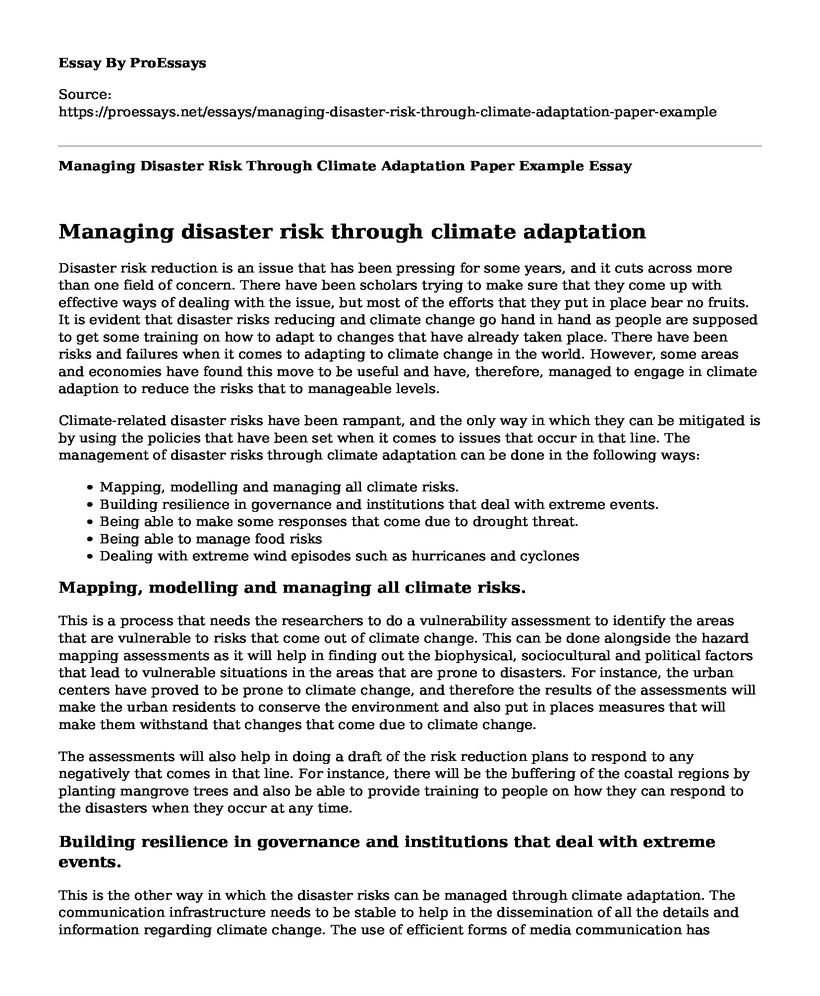Managing disaster risk through climate adaptation
Disaster risk reduction is an issue that has been pressing for some years, and it cuts across more than one field of concern. There have been scholars trying to make sure that they come up with effective ways of dealing with the issue, but most of the efforts that they put in place bear no fruits. It is evident that disaster risks reducing and climate change go hand in hand as people are supposed to get some training on how to adapt to changes that have already taken place. There have been risks and failures when it comes to adapting to climate change in the world. However, some areas and economies have found this move to be useful and have, therefore, managed to engage in climate adaption to reduce the risks that to manageable levels.
Climate-related disaster risks have been rampant, and the only way in which they can be mitigated is by using the policies that have been set when it comes to issues that occur in that line. The management of disaster risks through climate adaptation can be done in the following ways:
- Mapping, modelling and managing all climate risks.
- Building resilience in governance and institutions that deal with extreme events.
- Being able to make some responses that come due to drought threat.
- Being able to manage food risks
- Dealing with extreme wind episodes such as hurricanes and cyclones
Mapping, modelling and managing all climate risks.
This is a process that needs the researchers to do a vulnerability assessment to identify the areas that are vulnerable to risks that come out of climate change. This can be done alongside the hazard mapping assessments as it will help in finding out the biophysical, sociocultural and political factors that lead to vulnerable situations in the areas that are prone to disasters. For instance, the urban centers have proved to be prone to climate change, and therefore the results of the assessments will make the urban residents to conserve the environment and also put in places measures that will make them withstand that changes that come due to climate change.
The assessments will also help in doing a draft of the risk reduction plans to respond to any negatively that comes in that line. For instance, there will be the buffering of the coastal regions by planting mangrove trees and also be able to provide training to people on how they can respond to the disasters when they occur at any time.
Building resilience in governance and institutions that deal with extreme events.
This is the other way in which the disaster risks can be managed through climate adaptation. The communication infrastructure needs to be stable to help in the dissemination of all the details and information regarding climate change. The use of efficient forms of media communication has proved to be better when it comes to the spreading of all the information regarding hazards and evacuation after a disaster has occurred. It helps in making people identify all the early warning signs of a disaster and hence the necessary action can be taken immediately. The main focus, in this case, is to make people and agencies to become resilient whenever a disaster occurs.
Being able to make some responses that come due to drought threat.
The use of Geographical Information Systems (GIS) has been investigated and found out to be the perfect tools when it comes to drought preparedness. Drought is a climate change disaster that leads to the loss of lives and also the destruction of crops in some farms where it occurs. In that case, the use of GIS tools helps in climate adaptation as it has internet connected hubs that support the connection of computers that run the software. The software is then used to identify areas that will be affected by drought and therefore the necessary measures regarding preparedness are put in place. Being prepared has always helped in being resilient when it comes to disasters risks that occur due to climate change.
Being able to manage food risks
The other way in which disaster risks can be reduced through climate adaptation is by making use of a local adaptation plan while focusing on incidents such as flooding. In that case, this can be carried out by coming up with a plan that incorporates the technical, environmental, organizational and institutional measures that are seen in households. Also, there can be the use of remote sensing and GPS to verify some of the flood management techniques.
Dealing with extreme wind episodes such as hurricanes and cyclones
Extreme wind episodes lead to disasters such as the loss of lives and the destruction of property. This is an issue that can be managed by climate adaption. For instance, the cyclones and hurricanes can be controlled by planting mangroves to reduce the extreme wind episodes and the chances of getting to the settlements that are around the seashores. There can be the construction of cyclone shelters which can withstand the pressure and speed of hurricanes. If at all these measures are put in place then disaster risks that come out of climate change will be managed fully.
Cite this page
Managing Disaster Risk Through Climate Adaptation Paper Example. (2022, May 26). Retrieved from https://proessays.net/essays/managing-disaster-risk-through-climate-adaptation-paper-example
If you are the original author of this essay and no longer wish to have it published on the ProEssays website, please click below to request its removal:
- Risks in the Banking Industry
- Essay Example on Management: Leadership Challenge in an Organization
- Paper Example on Understanding Teamwork and Ideation Process
- Research Paper on Ethical Organizational Culture
- How Administrative Theory Relates to Higher Education Essay Example
- Essay Sample on Strategy-Driven Talent Management: Key Benefits & Challenges
- Jonathan Lee, Experienced DNP, APRN & Medical Director of Primary Care Practice - Report Example







